The post Students use virtual reality to transform stroke recovery appeared first on UBC Okanagan News.
The post From the classroom to the vineyard appeared first on UBC Okanagan News.
The post The future of wildfire appeared first on UBC Okanagan News.
When Dr. Adam Ford spots a mule deer meandering through a subdivision, he loves knowing not just what she eats, but where she spent the last summer and her routes through the Okanagan landscape. Most importantly, he loves knowing his research supports this deer’s very existence in BC.
It’s this kind of real-world impact that led Dr. Ford to be named UBC Okanagan’s 2024 Researcher of the Year in Natural Sciences and Engineering.
As the Canada Research Chair in Wildlife Restoration Ecology (Tier 2) and an Associate Professor in Biology, Dr. Ford leads the Wildlife Restoration Ecology (WiRE) Lab to explore how humans affect the predators and prey around them. His research ranges from minimizing human/bear conflict to understanding people’s opinions on ways to protect caribou.
While much of his work is focused on BC, a UBC Killam Accelerator Research Fellowship is helping expand Dr. Ford’s research in Kenya. Just as elk encounter human-made roadblocks from new cherry orchards in Kelowna, giraffes in Kenya face increased mango crops along the river, which block their drinking water and create conflict with humans when the giraffes eat the mangoes.
“It’s like two versions of the same story,” says Dr. Ford. “The questions in Kenya are very similar to what we’re doing here in BC.”
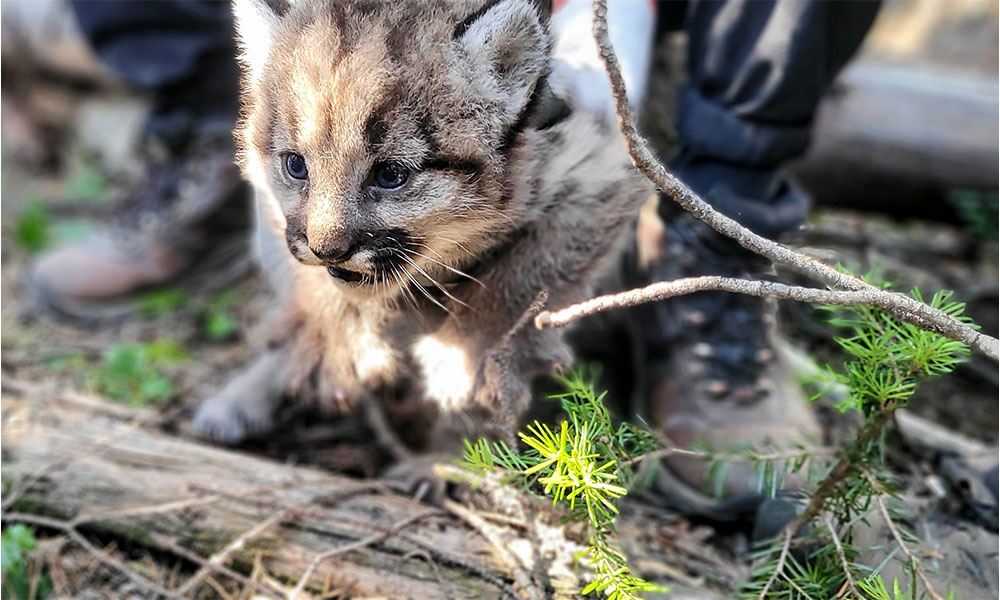
In southern British Columbia, cougars are understudied predators of declining mule deer and other large hooved mammals. As part of the Southern BC Cougar project, Dr. Ford and the team deployed GPS collars on 51 adult cougars and ear-marked 42 cougar kittens. Photo courtesy of Dr. Adam Ford.
His research often follows the lead of Indigenous conservation and restoration, like the West Moberly First Nations’ and Saulteau First Nations’ successful recovery of the Klinse-Za caribou population. Through actions like habitat protection and a maternal pen that allowed caribou to give birth away from predators, Dr. Ford’s lab found the herd grew from 30 caribou in 2013 to over 136 animals in 2023.
“The motivation and the leadership of the caribou recovery came from the communities. It was a huge privilege to be part of that work,” says Dr. Ford.
His engagement with communities and governmental organizations often leads to real-world impacts well before academic publications, like when he saw the threat of chronic wasting disease (CWD) entering BC through Alberta and Montana.
Sometimes called “zombie deer disease,” this fatal disease causes animals to become lethargic and waste away. CWD can spread through the deer family to caribou, already a threatened species in Canada. While not yet documented, there’s potential for CWD to jump the species barrier to humans through infected meat, similar to how mad cow disease has a human variant.
“There are huge implications for the spread of CWD in communities that are dependent on wild game, including many Indigenous communities and rural communities,” says Dr. Ford.
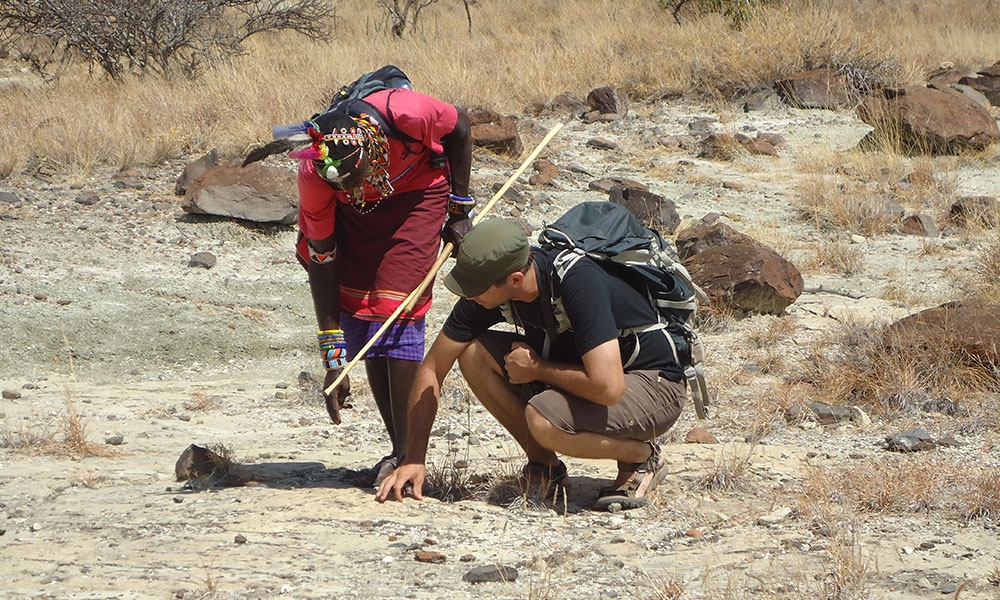
Here, Dr. Ford is seen tracking a Cape buffalo in Laikipia, Kenya. As part of his UBC Killam Accelerator Research Fellowship, Dr. Ford is building his research program with partners in the country. Photo courtesy of Dr. Adam Ford.
Upon seeing this risk, Dr. Ford was able to rapidly put together a study that identified gaps in provincial sampling where CWD could cross into BC undetected. They directly shared this report with the BC government, which changed the areas for mandatory deer testing as a result.
Unfortunately, the province did identify the first documented cases in BC in early 2024—in one of the same hot spots Dr. Ford’s lab predicted.
Dr. Ford points to funding and support from UBC Okanagan that helped him act so promptly, getting tracking collars out in the field as soon as they were needed.
“I can’t imagine anywhere else I’d rather be to do this work. I can look out my front door and know there are grizzly bears, elk migrations, wildfire… All the dynamics that go into our work are right here.”
He notes that his Researcher of the Year recognition is due to years of hard work from not just him, but everyone in the WiRE Lab.
“This award is testament to the hard work of my students and staff and the trust our partners have put in us. We’re tackling problems that matter to people, and we’re making a difference.”
The post Restoring nature’s broken links to help wildlife appeared first on UBC Okanagan News.
ALISA CHUNG BEGAN HER UNIVERSITY SEARCH WITH A CLEAR VISION: find a reputable institution to study physics that also offered a smaller, intimate setting with an international flavour.
Originally from Los Angeles, California, Chung ventured to Portland, Oregon, during high school. But when it came time to choose a university, she decided to go beyond national borders and look for a more global educational experience.
UBC Okanagan stood out as the perfect fit, not only providing a world-class physics program but also a diverse and welcoming community. The university’s emphasis on balanced teacher-to-student ratios appealed to Chung, ensuring a personalized and enriching learning experience.
While Chung’s primary focus of study is physics, university enabled her to reignite a long-held passion for art history. That eventually led her to pursue a Bachelor of Science degree with a major in physics and a minor in art history and visual culture.
Chung says that art history classes help her engage the creative side of her brain, encouraging her to think differently about topics lacking a definitive answer.
“I’m excited about exploring critical thinking in the context of culture, power dynamics and gender relations,” she says, adding that studying the intersection of art history and physics is a fascinating way to understand the world.
“This kind of critical thinking intertwined with a creative perspective, encourages me to view things differently. Questioning who has examined them before, to think about why, and explore more diverse perspectives.”
In the realm of physics, Chung says there’s an acknowledgment that mathematics is a philosophy on its own; a unique way of analyzing, viewing and processing the world.
“I believe art history operates similarly—there’s a distinct approach to understanding how the world functions and how we navigate through it. This dual fascination with physics and art history has been an immensely enjoyable and thought-provoking journey for me.”
Through her studies in art history and visual culture survey classes—taken in the Faculty of Creative and Critical Studies—Chung is able to further analyze the Eurocentric, gender-biased concept of genius in both art and science.
“This helps shed light on the need for a more inclusive and diverse narrative in teaching; in both my art history and science classes, we question why certain figures are elevated in academic discussions and others aren’t.”
Chung says that she has seen that art history progressively re-evaluating and incorporating diverse perspectives, but the history of science remains entrenched in gender bias.
“This realization made me think about the pragmatic mindset prevalent among scientists; why should we care about the narrative of our history?
“I’m working to apply the principles of analyzing art or texts in art history to show the importance of delving into the biases ingrained in scientific journals.”
Chung believes there is room for art history’s analytical lens in the world of science.
“Thanks to my degree from UBC Okanagan, I can apply a fresh perspective to teaching math and science, addressing gender biases and exploring innovative approaches to educating future generations.”
The post An undergraduate’s journey from physics to Picasso appeared first on UBC Okanagan News.
WHETHER HE’S HIKING A NEW PEAK or setting up cameras for field research, Dr. Adam Ford can’t help but see the Okanagan Valley’s incredible beauty—and the intense pressure the region is under.
“The Okanagan is exceptionally diverse ecologically,” says Dr. Ford, an Associate Professor of Biology in the Irving K. Barber Faculty of Science and the Canada Research Chair in Wildlife Restoration Ecology (Tier 2).
“We have salmon swimming in large lakes right beside a desert with cacti and rattlesnakes, grasslands with badgers, and within a 60-minute drive you can be above the tree line in an alpine meadow with mountain goats and grizzly bears. It’s also a vibrant, food rich and urban place—one of the fastest-growing communities in Canada because people want to be here. It’s beautiful.”
With that agricultural and urban growth comes challenges to biodiversity, such as water limitations, development through wildlife corridors and the shrinkage of rare grasslands.
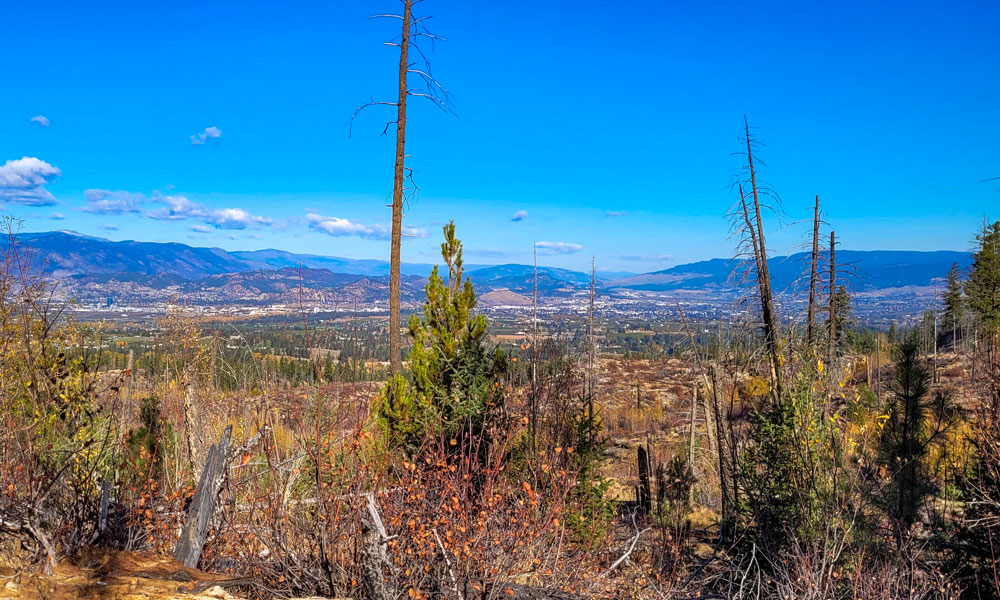
Plants have returned to the site of the devastating 2003 Okanagan Mountain Park fire, and this area now supports a vibrant wildlife community. Between the City of Kelowna and the fire are many agricultural operations, including fruit orchards and vineyards, making this land some of the highest valued real estate in Canada.
As the new Director of the Okanagan Institute for Biodiversity, Resilience and Ecosystem Services (BRAES), Dr. Ford wants the institute—and UBC Okanagan—to support local communities, land, wildlife and water, offering research that helps build a more sustainable way of life in the Okanagan.
BRAES is one of five research institutes at UBC Okanagan, funded by the Office of the Vice-Principal, Research and Innovation to provide opportunities for researchers to collaborate and share knowledge across disciplines and into the community.
As the head of BRAES, Dr. Ford hopes to strengthen the institute’s research support network. His priorities include strong regional partnerships and speaking to the need for reconciliation, including support for indigenizing research programs and partnering with Indigenous communities, particularly in the Syilx territory where UBC Okanagan is located.
His background has positioned him well for the new role.
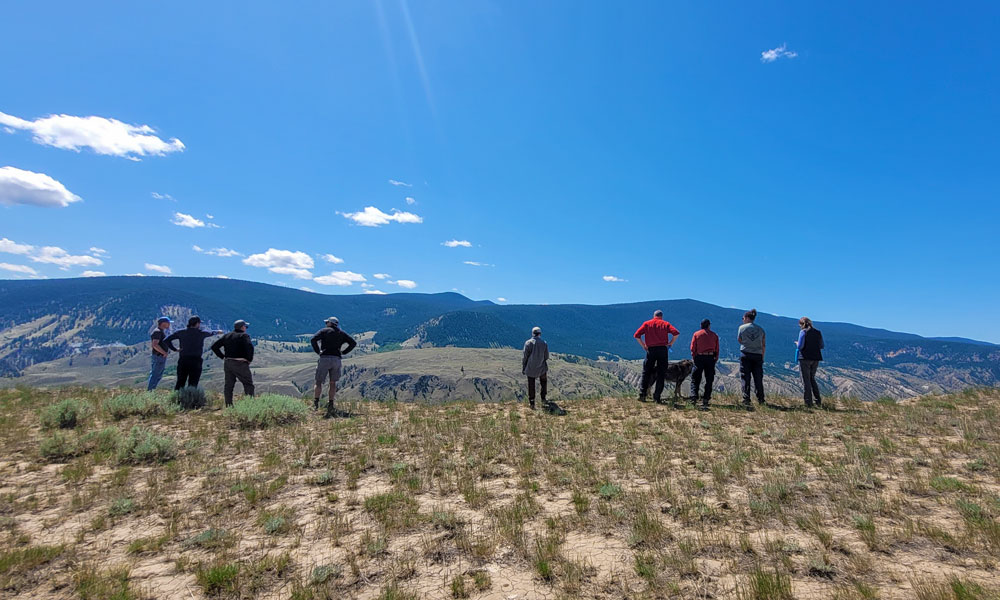
Community leaders from Esk’etemc First Nation, BC Wildfire Service, non-governmental organizations and BRAES researchers gather to plan cultural and prescribed fire in the Cariboo region. Indigenous-led fire management is helping to reinvigorate cultural practices and restore populations of wildlife species like bighorn sheep, elk and mule deer.
Dr. Ford leads the Wildlife Restoration Ecology (WiRE) Lab, where he studies how human activity in landscapes affects interactions between large predators, prey and plants. The key goal of this work is restoration—the human-assisted recovery of nature. To do this, he and his lab partner with governments, Indigenous communities and other organizations to help people and wildlife co-exist more peacefully.
His past and ongoing research projects include an award-winning study of the tripling of a mountain caribou herd under Indigenous-led stewardship, informing on human/wildlife conflict with wolves in coastal BC and bears in the Rocky Mountains, and assessing the functionality of wildlife corridors in BC—or, areas set aside from human development to allow animals to move through the habitat.
“Dr. Ford brings energy, creativity and extensive research experience to the leadership of BRAES,” says Dr. Phil Barker, Vice-Principal, Research and Innovation. “His work in conservation and regional collaborations are a perfect fit for the BRAES mandate, and I am looking forward to seeing how he will use this role to benefit not just the institute and our campus, but the wider sustainability conversation in the Okanagan.”
While many researchers in BRAES are biologists like Dr. Ford, interdisciplinarity is one of the institute’s key strengths.
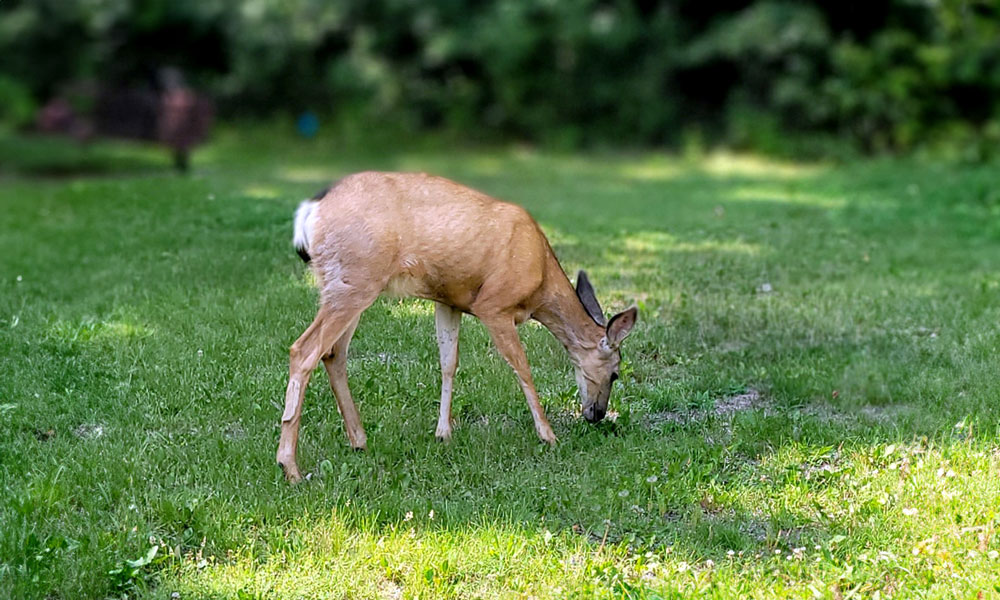
As an indicator species, mule deer are the “canary in the coalmine” that tells researchers about the health of the landscape. Dr. Ford helps lead the province’s largest mule deer study to date—the Southern Interior Mule Deer project—involving several graduate students, hundreds of trail cameras and GPS tracking of deer migrations.
BRAES connects researchers across disciplines, from biology to computational statistics to the humanities. For Dr. Ford, these diverse skills are essential to solving complex problems like climate change and sustainability.
“The world is a complicated place, and we need a lot of different ways of knowing to help solve these problems,” he says. “Western science can be a helpful tool, but it’s just one tool in the toolbox. To solve complicated problems, we need a diverse set of tools.”
In the future, Dr. Ford dreams of UBC Okanagan researchers having access to field research facilities in the Okanagan, coordinating with community partners on long-term biodiversity monitoring for the valley and hiring an interdisciplinary postdoctoral fellow who could work across faculties in BRAES.
“You can look at the recent wildfires in the Okanagan and see the need for the work BRAES members do to support better decisions and give the landscape a voice,” says Dr. Ford. “We care about this community, and we’re doing work that we believe will help the Okanagan.”
The post Balancing humans and habitat in biodiversity appeared first on UBC Okanagan News.
The post UBC Okanagan’s Bachelor of Sustainability a degree of change appeared first on UBC Okanagan News.
The post Learning to live with wildfire appeared first on UBC Okanagan News.
The post Undergraduate students think big with living light bulb appeared first on UBC Okanagan News.
The post An Indigenous approach to understanding water appeared first on UBC Okanagan News.
